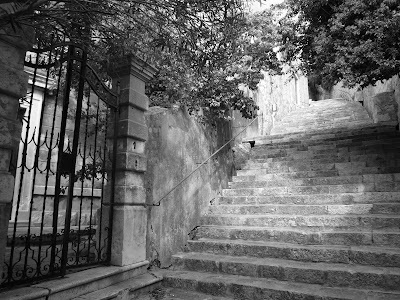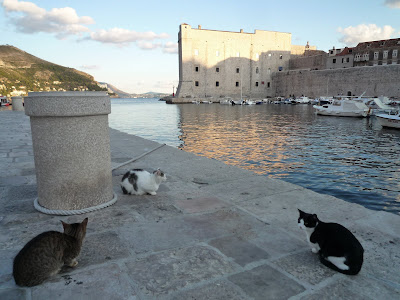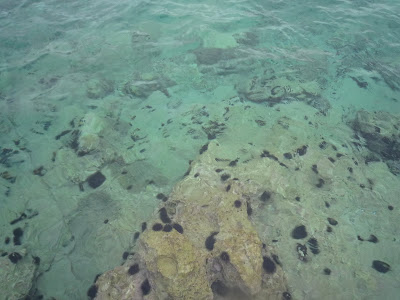Croatia is a quickly developing land in southeastern Europe, and in its modern form a product of the disintegration of Yugoslavia in the 1990s. The shape of the country on a map resembles a scythe. The blunt handle heads east and inland toward Serbia and Hungary; the tapering blade follows the coast of the Adriatic Sea to the south until reaching Macedonia. All along the way thousands of islands linger off the rocky beaches. Across the Adriatic from the country lies Italy. The four and a half million citizens of the country speak Croatian, and are opening up their home more and more to foreign tourists. The lower part of the country, where I traveled, is known as Dalmatia. The following is brief summary of the trip, with the pictures mostly speaking for themselves.
About two months ago today, Julie and I boarded a plane from a low-cost airline and flew to Dubrovnik, the so-called "pearl of the Adriatic." In the small airport a border guard checked my passport and greeted me to Croatia by comparing me to Nicholas Cage.
Dubrovnik is a relatively small city of only about 50,000 people but is quickly becoming an international tourist destination. Actually, tourists from Western Europe had re-discovered this beautiful community shortly after the armed conflicts in the early 1990s ceased. Since then it has been growing in popularity with visitors from the Western hemisphere, and for good reason. The city is basically as far south as possible in Croatia before crossing into Macedonia. The old town sits on a rocky peninsula and is surrounded entirely by the city's Medieval defensive wall. Though damaged during the recent war, much of the old town has been wonderfully restored. Walking through the historic heart of Dubrovnik is a tour through marble plazas and lush, shaded staircases.




One of the high points with a visit to Dubrovnik is a walk along the city's foremost landmark: it's city walls. A complete circumnavigation around the old town offers some of the most rememberable real-life postcards a visitor may ever see. Here are several shots of the city as seen from the walls. In the first there's a glimpse down the main promenade; as far as I could tell, cars cannot enter the old town. The resemblance to Venice is no coincidence, the cities once competed with each other for glory.



Look hard and you can still notice the local day-to-day life behind the tourist crowds in the old town. Here a dish-washing hand reaches through a window to set a pan out to dry.




As in the past, the city's life is strongly connected with the sea. Dubrovnik provides more than a couple harbors, but the most charming is located in the old town.

I would also have to say that this is a city of stray cats. Their purrs could be heard around nearly ever corner.

A short boat ride from the old town is the inational park of Lokrum, an uninhabited island and national park. Thick Mediterranean forests cover the island's hilly landscape, and rock-strewn beaches and cliffs hug the shores. A Benedictine monastery once housed monks on Lokrum, but today only its ruins remain, as seen in the first photo below.



The waters of the Adriatic around Croatia are famous for their sparkling blue character and remarkable clarity. Snorkeling at the remote beaches of Lokrum could not be resisted. The underwater environment of several yards deep offered views of colorful schools of fish, sea urchins, and other swimming creatures.

Night delivered golden vistas of the city, especially around the old town's harbor.


After a few days we left Dubrovnik and headed north on a bus. The mainland portion of Croatia is interrupted for several kilometers by Bosnia-Herzegovina. During a brief stop at a rest stop along the road in this country I snapped the picture below. Closer inspection revealed that the holes on the sign were indeed caused by gunfire.

Soon back in Croatia we reached another one of Croatia's principal cities, Split. From here we transferred to ferry, and by the end of the afternoon we arrived at our destination, the island and village of Hvar. Here we found what looked like a quaint relative of Dubrovnik, fewer tourists, and remarkably clearer water than at Lokrum. The image below shows a view from the harbor into the water, the black dots are sea urchins on the rough floor.

A couple days in Hvar gave us plenty of time to walk around the village and seek out its most attractive spots. The first photograph below shows a view from an old castle that overlooks the community.

Here are a few more shots from the harbor and cityscape of Hvar. The dogs in the second photo seemed to be waiting for me.



On our last day in the country we started our return to Dubrovnik's airport early in the morning so that we could spend a few hours in Split. The city of more than 200,000 offers some trips into classical history with its Roman ruins.

The old town is literally built into the remains of a Roman palace. Emperor Diocletian of the Roman Empire left his ruling position near the fourth century AD and had a retirement palace constructed for him in Split, the capital of the then-Roman province of Dalmatia. Much of the structure of Diocletian's Palace has remained amazingly intact through the centuries, and today the residences and shops of the old town appear perfectly integrated into the ancient walls. Steps even lead to a subterranean portion that now houses a bazaar. Here a couple photographs of the palace remains and old town.


Another interesting place in Split was the fish market, though it did appeal more to the eyes than the nose.

Pleasantly fitting on our last day in Dalmatia was seeing none-other than possibly the most well-known export from the region--a dalmatian. And this one seemed quite the chic canine.

We arrived back home in Germany close to midnight that day, and the semester would be starting for me in less than a week. With the semester came all of the unexpected events and work that have regretfully kept me from posting more frequently. Fortunately, free time has again found its way to me.